Research Interest





Welcome to group
Antibacterial activity
Array based sensing
Photocatalysis
Bottom-up Synthesis
2 - 5
<
>
Synthesis and functionalization of layered materials:
We are interested in synthesis of laterally size controlled 2D single/thin-layer molecular assemblies by chemical synthesis/possessing (top-down/bottom-up method) from their corresponding precursors such as bulk materials, single molecular unit, single crystals etc. Currently we are working on graphene oxide, TMDs and 2D-organic framework. We are also working on pre- and post- synthetic surface modification of those layered materials.

Molecular recognition
Recognition of macromolecular surfaces using synthetic receptors has considerable potential with various applications in biomedical and biomaterial research. Recognition of macromolecular surfaces using synthetic receptors is based on noncovalent host-guest interaction as observed in small molecular systems. Macromolecule and nanoparticle based scaffolds include multivalent libraries of receptors demonstrate a certain level of success in modulation of macromolecular function; but the efficiency and applications still remains indistinct. In this regard layered based nanostructure receptors can offer a platform for macromolecular surface recognition which is unique and distinctive in its own way such as, maximum surface to volume ratio, tunable surface functionality, wide range of electric and optical properties, mechanical flexibility etc. Our group want to explore this recognition ability of layered materials with other layered materials and targeted molecules using specific/nonspecific surface functionalization.
Molecular sensing
Successful molecular surface recognition can be extent to various sensing application. Sensors play an important role in an array of areas, including biomedical diagnosis, forensic analysis, and environmental monitoring. A number of factors are critically related to the efficiency of sensors, including response time, signal-to-noise (S/N)/sensitivity, and selectivity in the presence of interfering species. As a result, significant emphasis has been placed on improving the recognition and transduction mechanism through the use of new materials. To this end layered nanostructures are attractive tools for sensor design due to their size, unique physicochemical properties and high surface areas. Based on surface recognition two type of sensor can be developed, optical signal based sensor and electronic response based sensor. We are working on develop of both kind of sensors based on layered materials as they are suitable for recognition and transduction of signal optically as well as electronically. We want to extent this techniques beyond the simple protein to other health and environmentally related molecules (e.g. bacteria, cancer cell, macromolecules, pesticides etc.).
Antimicrobial activity
The layered materials can demonstrate strong and enhanced antimicrobial activity due to the sharp edge effect, terminal electron acceptor and strong interaction to the microbial membrane which lead to the destruction of membrane integrity. As the physical, electronic and surface properties can be modulated by using different materials and functional ligands we are exploring the cytotoxicity and antibacterial activity of chemically exfoliated and functionalized 2D materials.
Catalytic activity
In addition to these biological applications mentioned above, a particularly exciting breakthrough has emerged in the area of nanocatalysis. The field of nanocatalysis has undergone an explosive growth during the past decade, both in homogeneous and heterogeneous catalysis in which nanomaterilas are used as a catalyst. However the application of 2D nanomaterial as catalyst in organic synthesis is very limited. With the help of Graphene Oxide (GO), by using -interaction, the reaction associated with -transition state is possible to expedite. Based on this strategy we have successfully developed an efficient protocol for Diels-Alder reaction between 9-hydroxymethylanthracene and N-substituted maleimides using GO as a carbocatalyst in an aqueous medium at room temperature. High yield, wide substrate scope, low or room temperature reaction henceforth exceptional functional group tolerance and water as green solvent are the noteworthy features of this protocol.
Similarly photocatalytic activity of 2D MoS2 was applied in preparation of Schiff bases. In that experiment 2D-MoS2 has shown a good photocatalytic activity towards the oxidation of primary aromatic amines to their corresponding imines in good yield and wide substrate selectivity. This is the first time application of 2D-MoS2 in organic functional transformation. Currently we are working on other related synthetic methodologies.
Department of Organic Chemistry, Chemical Science Division
New Chemical Science Building, Second Floor
Room No - E 202, E 204, E 206, E 208 Office: E 213,
Tel: +91-80-2293-2042 (Office) / 2436 (Lab)
Fax: +91-80-2360-0529/0683
E-mail: md@iisc.ac.in
Indian Institute of Science
Bengaluru-560012, Karnataka, India
Designed by Pradipta